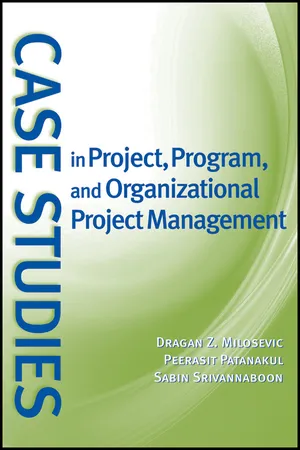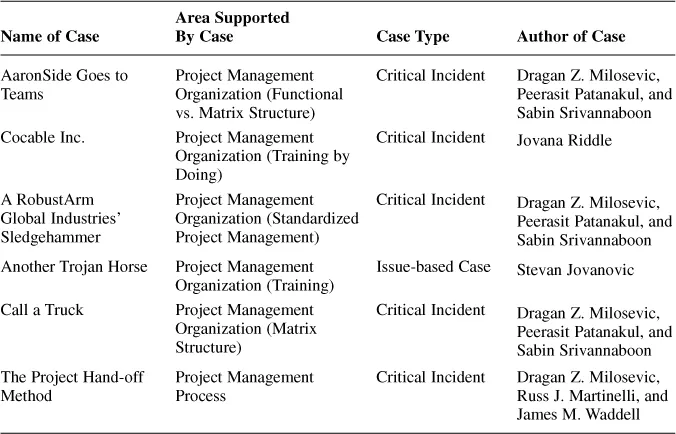![]()
Part I
Case Studies in Project Management
What is Project Management?
It is well recognized that project management has been practiced since early civilization. The evidences from past history to the present are abundant: the construction of the Great Pyramids of Giza in the ancient world, the Great Wall of China construction in the 16th century, and the London Millennium Bridge in the globalization era. Without project management, these structures would not have existed.
With a competitive business environment, many organizations nowadays use projects not only to build structures, to implement changes, or to introduce new products, but also as a way to put strategies into action. Despite multiple meanings of a project, the one defined by Project Management Institute (PMI) is perhaps the most widely known definition. According to PMI, a project is a temporary endeavor undertaken to create a unique product, service, or result.1 With its temporary nature, a project is often perceived as standing on the opposite spectrum of business as usual; it is often referred to as an “operation” by project management scholars. As projects differ from operations, managing projects therefore requires a discipline2 of planning, organizing, and managing resources to bring about the successful completion of specific goals and objectives. This discipline is referred to as project management.
The discipline of project management has evolved from different fields of application. The work of Frederick Winslow Taylor on theories of scientific management is considered to be the foundation of project management tools, such as the Work Breakdown Structure. The Gantt chart, developed by Henry Gantt, is recognized as a forefather of project management planning and control techniques. And the work of Henri Fayol on management functions is the foundation of project and program management body of knowledge.
However, it wasn't until the middle of the 20th century that project management was recognized as a formal discipline.3; emerging from the construction of the first atomic bomb during World War II (the project known as the Manhattan Project). Since then, more and more new processes and disciplines have emerged that support the use of project management, including Time Quality Management (TQM) in 1985, concurrent engineering in 1990, and reengineering in 1993, just to name a few. As a result, more and more project management tools and techniques have emerged, including the Critical Path Method (CPM) and Program Evaluation and Review Technique (PERT) in the 1950s, and the Critical Chain Project Management in 1997.
As the discipline of project management has grown, the standards governing the field have also evolved. While each organization practicing project management may develop its own criteria, several national and international organizations have proposed project management standards. These standards are, for example, A Guide to the Project Management Body of Knowledge (PMBOK® Guide) from the Project Management Institute in the United States and PRINCE2: 2009 Refresh (PRoject IN Controlled Environment) from the Office of Government Commerce in the UK. Among these standards, the PMBOK Guide receives strong recognition from project management communities.
The PMBOK Guide suggests nine knowledge areas of project management: integration management, scope management, time management, cost management, quality management, human resource management, communication management, risk management, and procurement management. These knowledge areas are used as skeletons for organizing case studies in Part I.
1A Guide to the Project Management Body of Knowledge, 4th ed., Project Management Institute, 2008, p. 5.
2David I. Cleland and Roland Gareis, Global Project Management Handbook, McGraw-Hill Professional, 2006.
3Aaron J. Shenhar and Dov Dvir, Reinventing Project Management: The Adaptive Diamond Approach, Harvard Business School Press, 2007.
![]()
Chapter 1
Introduction
Chaper 1 presents examples of organizations that have recognized the importance of projects as an engine of their growth or a survival mechanism during economic turbulence. Various efforts of these organizations in response to the need for project management, therefore, were initiated.
In this chapter, there are six case studies: five critical incidents and one issue-based case. The cases generally discuss a number of concepts (e.g., organizational structures), that can be found in Chapters 1 (Introduction) and 2 (Project Life Cycle and Organization) of A Guide to the Project Management Body of Knowledge (the PMBOK® Guide).
1. AaronSide Goes to Teams
2. Cocable Inc.
3. A RobustArm Global Industries’ SledgeHammer
4. Another Trojan Horse
5. Call a Truck
6. The Project Hand-off Method
These cases demonstrate different situations where companies made the transition from non-project-oriented organizations to project-oriented ones. To capture the transition efforts from multiple views and settings, we offer cases from different industries: “AaronSide Goes to Teams” is in the metal machining industry; “Cocable Inc.” is in cable manufacturing business; “A RobustArm Global Industries’ SledgeHammer” providesbuilding materials; “Another Trojan Horse” is in the nuclear industry; “Call a Truck” offers shipping and transportation services; and “The Project Hand-off Method” is from the field of medical equipment manufacturing.
Chapter Summary
AaronSide Goes to Teams
Dragan Z. Milosevic, Peerasit Patanakul, and Sabin Srivannaboon
It took AaronSide, Inc. almost 80 years to grow from a small mom-and-pop business to a company that held the largest market share internationally. What made this feat special was that a single family owned the company since its inception. It is suffice to say that this success made owners, management, and all employees more than proud.
A Wall is Between Us
Operating in the metal machining industry, AaronSide's organization was perfected over time through experience and many saw this as a competitive advantage. Basically, it was an efficient, functional organization where marketing, engineering, and manufacturing with a strong quality group played a major role. The engineering department achieved the fastest 16-month lead time for a new product development project when compared with competitors. Fundamentally, product development was an operation that worked like a well-oiled machine. It started with marketing, which did market research and then threw the specification of what customers desired “over the wall” to the engineering department, which released final drawings to manufacturing, which made the quality product. The approach was called the relay race. Its secret was an efficient, functional department. Typically, if you worked in a specific department, say marketing, you would never talk to a guy from a different engineering. If you did, you might be reprimanded. Indeed, departments talk to each other, not individuals that belong to different departments. How do departments converse? Usually, only heads of departments are authorized to speak on behalf of their staff.
To Survive, Change is Required
The more intense globalization of business brought more international competition. The two largest rivals in the industry from Europe, subsidiaries of the large multinational organizations, largely expanded their operations in the U.S. market. This is when problems for AaronSide began to mushroom. AaronSide found it difficult to compete with the Europeans, who had access to resources and new management of their rich parents. As a result, AaronSide slipped to a close third in market share, behind the European rivals. Freefall continued and by 1990, AaronSide was the distant third. Several management teams were replaced during this period, new manufacturing equipment was installed, the company was seriously reengineered, and different management was used to catch up with the leaders without significant results. So, AaronSide became ripe for a sale.
After talking with four suitors from the United States and Europe over the last several years, owners concluded that the best offer for purchase of AaronSide was one from Titan Corp, a Swedish company. So, after almost 90 years of being family-owned, AaronSide became a wholly owned subsidiary of a large multinational firm.
To facilitate the integration of AaronSide into Titan Corp's network of companies, the management team of AaronSide was retained. The first initiative of the new owner was to direct AaronSide to commission a pilot project management team (in manufacturing companies usually referred to as concurrent engineering teams), cross-functional in nature, and made up of the permanent members from marketing, engineering, and manufacturing, and auxiliary members from finance and field repair. The team was chartered to develop a new mining vehicle in eight months, twice faster than usual and as fast as the world leader. The new team was empowered to make all major decisions. The idea was to accomplish success with this team, and then use it as a paradigm along with the lessons learned from its operation to establish a company-wide project management system.
Eight months later the project was not finished, and needed eight more months to reach its conclusion. The Swedish parent asked for an immediate investigation. The investigation showed that the team did not make any major decisions. Instead vice-presidents (VPs) who were heads of the departments directed the members of their team to make no decisions, but to bring all necessary information to them and they, the VPs, would make the decision. Having discovered this, the management of Titan Corp decided to fire the CEO and all VPs.
Discussion Items
1. What are the pros and cons of the relay race approach and the cross-functional team approach to product development projects? Which approach is better?
2. Who gets more power and who gets less power by shifting product development projects from the relay race to the cross-functional team approach?
3. Does the shift from the relay race to the cross-functional team approach require a significant cultural change? Explain why or why not.
4. Why do you think the VPs took the approach of not letting a pilot team make major decisions although the team was empowered to do so?
5. Was the firing of the CEO and all VPs justified? Why or why not?
Cocable Inc.
Jovana Riddle
Jane and Obanga
It was 6:30 on a Wednesday morning, and Jane Campbell was on her way to work. The traffic was heavy like any other day, which usually made Jane frustrated. Today, however, Jane was calm and didn't seem to mind the long drive. Why? The commute would give her time to think about what her next move at Cocable...

